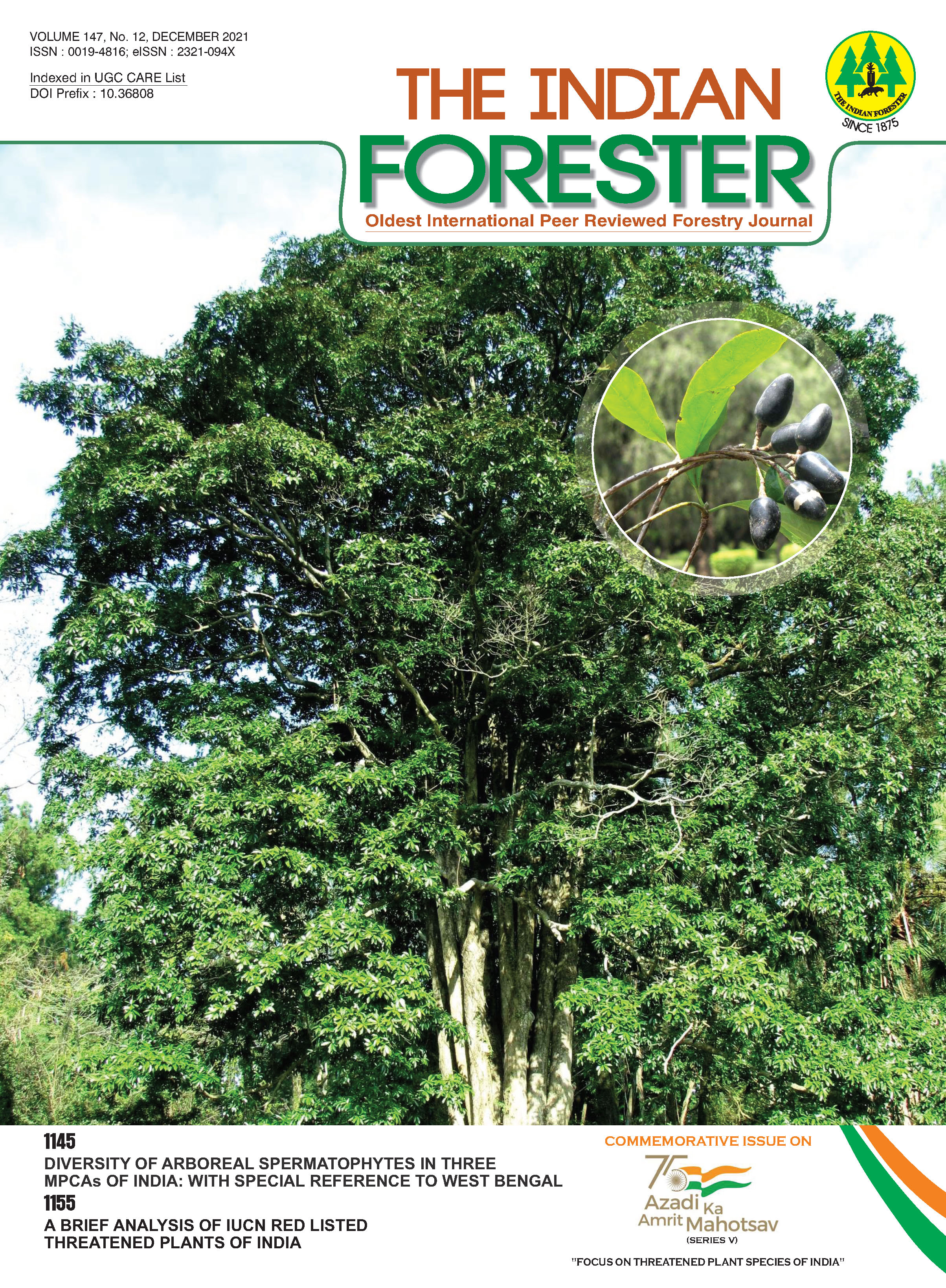Status, Distribution and Conservation of Terminalia coronata (Stapf) Gere & Boatwr. in India
DOI:
https://doi.org/10.36808/if/2021/v147i12/158802Keywords:
Terminalia coronata (Stapf) Gere and Boatwr., Endemic, Threatened, Rajasthan, India.Abstract
Present study deals with distribution, status and conservation of Terminalia coronata (Stapf) Gere & Boatwr. (Syn. Anogeissus sericea var. nummularia King ex Duthie) in India. Terminalia coronata locally known as Indrok/Indroka, is a multipurpose endemic and threatened tree species of fragile and stressed ecosystems of arid and semi-arid regions of north-west India. It has been observed that Indroka mostly prefers to grow in a gregarious form making pure patches in sandy-loam to loamy sand soil of the depressed areas like Naadi (dug out village ponds), Johad (small earthen check dam), valleys or bottom of the hills. Regarding the presence of this tree in Naadi people of Sawant Kua village said the Indroka trees were planted in Naadis because of their fibrous and lateral root system that helps in soil and water conservation. It comes under Indeterminate (I) global threat status of the species as per IUCN (1997), CITES Appendices I and as 'Rare' by Nayar and Sastry (1998), Bhandari (1990), WCMC (1994), IUCN (2002) GEC, MSU and GUIDE (2002). As per IUCN Red List criteria, we have assessed it as Endangered (EN).References
Aftab Gazala (2014). Satus and distribution of Anogeissus sericea var. nummularia in Udaipur district, Rajasthan (India). J. Chem. Bio. Phy. Sci. Sec., 4(4): 3293-3295.
Aftab Gazala, Banu F. and Sharma S.K. (2016). Status and distribution of various species of genus Anogeissus in protected areas of southern Rajasthan, India. International Journal of Current Research, 8(3): 27228-27230.
Bhandari M.M. (1978). Flora of the Indian Desert, Scientific Publishers, Jodhpur, 471Pp.
GEC (Gujarat Ecology Commission) MSU and GUIDE (2002). Conservation of rare and endangered Biodiversity of Gujarat. Final report submitted to Gujarat Ecology Commission, Gujarat, 428 pp.
IUCN (2001). IUCN Red List Categories and Criteria (Version 3.1). https://iucn-csg.org/red-list-categories/.
IUCN (2002). Red list of threatened species. Species survival commission (SSC). IUCN, Gland, Switzerland.
Kumar S. (2001). Flora of Haryana (Material) Bishen Singh Mahendra Pal Singh, Dehradun, 507 Pp.
Kumar S.R. and Kalavathy S. (2010). Status and distribution of the 'rare' (r) tree species, Anogeissus sericea Brandis var. nummularia King ex Duthie. in the forest of North Gujarat Region (NGR), Gujarat, India. Life Sciences Leaflets, 6: 178-181.
Meena K.L. and Yadav B.L. (2010). Studies on ethnomedicinal plants conserved by Garasia tribes of Sirohi district, Rajasthan, India. Indian Journal of Natural Products and Resources, 1(4): 500-506.
Meena K.L. (2013). Conservation priorities for endemic and threatened species Anogeissus sericea var. nummularia King ex Duthie-from Rajasthan, India. J. Econ. Bot., 37 (4): 636- 643.
Nayar M.P. and Sastry A.R.K. (1998). Red data book of Indian Plants (Vol.2), Botanical Survey of India, Calcutta, 92 pp.
Nair N.C. and Malhotra S.K. (1961). A study of the vegetation of Lohargal and its neighbourhood. Nelumbo, 3 (2): 139-151.
Pandey D.N. and Padhye P.M. (2007). Studies on Phytodiversity of arid Machia Safari Park-Kailana in Jodhpur (Rajasthan), Nelumbo, 49(1-4): 15-78.
Rosser A. (1992). Report on the CITES, the Tenth Conference of the Parties. Species, 29: 25-28.
Singh K. (2016) Effect of Land use types on floral diversity and carbon sequestration in Jodhpur district of Rajasthan. Ph.D. Thesis submitted to Forest Research Institute (Deemed) University, Dehradun: 182 Pp.
Singh G. (2014). Project completion report on studies on carbon sequestration in differed forest types of Rajasthan. Submitted to Indian Council of Forestry Research and Education (ICFRE), Dehradun, Uttarakhand: 272 Pp.
Singh G. (2016). Sacred groves of Rajasthan: Threats and Management Strategies, Scientific Publisher, 292 Pp.
Singh V.K., Barman C., Mohanty D. and Tandon R. (2018). Relative contribution of reproductive attributes to the densitydependent effects on fruit-set. AoB PLANTS, 10: (2) https://doi.org/10.1093/aobpla/ply019
Walter K.S. and Gillett H.J. (eds.) 1998. 1997 IUCN Red List of Threatened Plants. Compiled by the World Conservation Monitoring Centre. IUCN, Gland, Switzerland and Cambridge, UK. Lxiv+ 862 pp.
WCMC (World Conservation Monitoring Centre) (1994). Status Report of 24 November1994. Gujarat–Printout plant database. BG-BASE.
Downloads
Downloads
Additional Files
Published
How to Cite
Issue
Section
License
Unless otherwise stated, copyright or similar rights in all materials presented on the site, including graphical images, are owned by Indian Forester.





